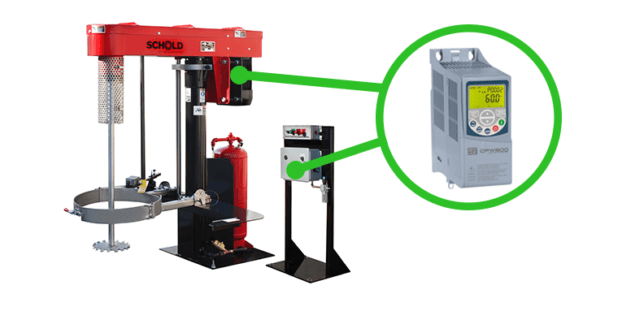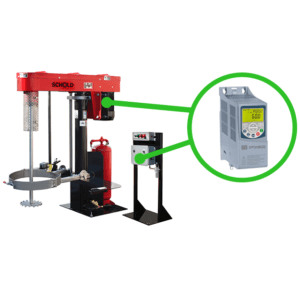Modernize Your Industrial Mixer:
Why VFD Conversions Are a Smart Investment
Mechanical Drives vs. VFDs — What’s the Difference?
VFDs, by contrast, use electronic control to adjust motor speed. This digital approach allows operators to fine-tune blade tip speeds with pinpoint accuracy. That means less downtime, more efficient mixing, and a longer lifespan for your equipment.

The Value of Modernization
- Lower operating and maintenance costs: With fewer moving parts and less mechanical friction, VFDs reduce the risk of breakdowns and the need for routine repairs.
- Quieter operation: Say goodbye to the loud, grinding sounds of aging pulley systems.
- Greater control: Adjust motor speeds on command to match your process needs — improving consistency and quality.
- Energy savings: When full power isn’t needed, VFDs ramp down motor speed, cutting energy use significantly.
Real-World Energy Savings
Estimated VFD Conversion Value by Motor Size:
| Motor HP | Annual Runtime (hrs.) | Avg Load (%) | kWh Rate ($) | Est. Annual Savings (Energy + Maintenance) | Payback Period ($20K–$30K) | Cumulative Inflation-Adjusted Savings at Payback | Deferred Replacement Cost Avoided |
|---|---|---|---|---|---|---|---|
| 30 HP | 2,912 | 70% | $0.15 | ~$7,400 | 3–4 years | ~$23,000 | $35,000–$45,000 |
| 50 HP | 2,912 | 70% | $0.15 | ~$9,300 | 2–3 years | ~$29,000 | $50,000–$65,000+ |
| 75 HP | 2,912 | 70% | $0.15 | ~$12,400 | 2 years | ~$25,000 | $60,000–$85,000+ |
| 100 HP | 2,912 | 70% | $0.15 | ~$15,600 | 1–2 years | ~$32,000 | $75,000–$100,000+ |
Motor HP: 30 HP
- Annual Runtime: 2,912 hours
- Average Load: 70%
- kWh Rate: $0.15
- Estimated Annual Savings (Energy + Maintenance): ~$7,400
- Payback Period: 3–4 years
- Cumulative Inflation-Adjusted Savings at Payback: ~$23,000
- Deferred Replacement Cost Avoided: $35,000–$45,000
Motor HP: 50 HP
- Annual Runtime: 2,912 hours
- Average Load: 70%
- kWh Rate: $0.15
- Estimated Annual Savings (Energy + Maintenance): ~$9,300
- Payback Period: 2–3 years
- Cumulative Inflation-Adjusted Savings at Payback: ~$29,000
- Deferred Replacement Cost Avoided: $50,000–$65,000+
Motor HP: 75 HP
- Annual Runtime: 2,912 hours
- Average Load: 70%
- kWh Rate: $0.15
- Estimated Annual Savings (Energy + Maintenance): ~$12,400
- Payback Period: 2 years
- Cumulative Inflation-Adjusted Savings at Payback: ~$25,000
- Deferred Replacement Cost Avoided: $60,000–$85,000+
Motor HP: 100 HP
- Annual Runtime: 2,912 hours
- Average Load: 70%
- kWh Rate: $0.15
- Estimated Annual Savings (Energy + Maintenance): ~$15,600
- Payback Period: 1–2 years
- Cumulative Inflation-Adjusted Savings at Payback: ~$32,000
- Deferred Replacement Cost Avoided: $75,000–$100,000+
- Runtime & Load: We estimate 2,912 annual hours (8 hours/day, 7 days/week) at 70% load — typical for industrial mixing applications.
- Energy Savings: VFDs typically reduce energy use by 10–30%. For example, a 30 HP motor might save over 12,000 kWh annually — translating to ~$1,800 per year at $0.15/kWh.
- Maintenance Savings: By removing wear-prone components like belts and gearboxes, VFDs save thousands per year in labor, downtime, and part replacement.
- Payback Period: Based on an average $20K–$30K conversion cost, the breakeven point ranges from 1 to 4 years, depending on motor size.
- Inflation-Adjusted Payback: Using a 3% inflation rate, total savings at breakeven range from ~$23,000 to ~$32,000 — showing how value compounds over time.
- Deferred Replacement: VFDs reduce wear on both motors and mechanical drives, delaying capital equipment replacement. In many cases, this defers $35K–$100K+ in machine upgrades.
Calculate your own estimated savings with WEG’s VFD Calculator. Questions about VFD conversions? Don’t hesitate to contact us for assistance.
Bonus Savings: Rebates, Emissions, & ESG Value
Beyond the core energy and maintenance savings, utility companies offer cash rebates or incentives for installing energy-efficient upgrades like VFDs. These rebates significantly shorten your payback period — sometimes by thousands of dollars.
Even more, VFDs conversions support CO₂ reduction goals and contribute to your organization’s ESG reporting or corporate sustainability initiatives. Whether you’re looking to meet compliance standards, reduce your carbon footprint, or promote green practices, energy-efficient upgrades like VFD conversions check all the boxes (along with the real financial benefits!)
In Summary...
Unlike energy rates or labor costs, a VFD investment is fixed. Every year you delay, costs go up — but your savings potential remains. VFD conversions aren’t just an upgrade; they’re a hedge against rising operating expenses, a tool for modernizing operations, and an investment in long-term plant efficiency.
“We upgraded two dispersers to VFDs last year with Schold’s help — the difference is night and day. Our operators love the quieter run, and we cut our energy use by over 15%. Wish we had done it sooner!”
– VP of Operations, Coatings Industry
“Our old pulley drives were becoming a maintenance headache. The VFD retrofit gave us better speed control and saved us thousands on repairs. Schold made the transition seamless.”
– Maintenance Manager, Adhesives Industry
Questions? Quote Request?
We are here to assist. Get started with your VFD conversions and start saving today:

